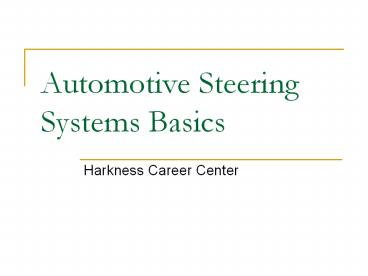Automotive%20Steering%20Systems%20Basics - PowerPoint PPT Presentation
Title:
Automotive%20Steering%20Systems%20Basics
Description:
Automotive Steering Systems Basics Harkness Career Center Steering Systems Manual steering system ... Why do most vehicles use a rack and pinion design? – PowerPoint PPT presentation
Number of Views:786
Avg rating:3.0/5.0
Title: Automotive%20Steering%20Systems%20Basics
1
Automotive Steering Systems Basics
- Harkness Career Center
2
Steering Systems
- Manual steering system relies solely on the
driver to provide steering force - Power assist (power steering) uses hydraulic
or electric power to help the driver apply
steering force
3
Steering Systems
- Both manual and power steering systems have
common components. - Input components
- Steering wheel
- Steering column
- Steering shaft
4
Steering Column and Wheel
5
Steering Shaft
6
Steering Shaft to Gear
- The steering shaft connects to the steering gear
through one or more - Universal joints
- Flexible steering coupler
7
Steering Systems
- The steering gear changes the rotary motion of
the wheel into linear motion of the steering
linkage.
8
Steering Gear
9
(No Transcript)
10
Rack and Pinion Steering Gear
11
(No Transcript)
12
Steering Linkage
- Connects the linear motion of the steering gear
to the steering arms. - Parallelogram type linkage (typical)
- Pitman arm
- Idler arm
- Center link
- Inner tie rod
- Outer tie rod
- Tie rod adjustment sleeve
13
Parallelogram Type Linkage
14
Parallelogram Type Linkage
15
Parallelogram Type Linkage
- Parallelogram refers to the shape that the
linkage makes on a turn.
16
Parallelogram Type Linkage
Pitman Arm
Idler Arm
17
Steering Linkage
- Rack and Pinion linkage
- Inner tie rod
- Outer tie rod
18
Ball Sockets
- Allow suspension travel without binding
- Tie rods located at the steering knuckle.
- Also at the center link on parallelogram type.
- Ball joints located at the top and bottom of
the knuckle. Allows for movement between the
knuckle and control arm(s).
19
Steering Knuckle
20
Tie Rod
21
Ball Joints
22
Recirculating-Ball Steering Gear
- Primarily used on trucks, vans and larger
vehicles. - Also used on most passenger vehicles prior to
1980. - Used in conjunction with a parallelogram-type
linkage system.
23
Recirculating-Ball Steering Gear
- Uses a series of recirculating balls on a worm
shaft to transfer steering-wheel movement to tire
and wheel movement.
24
Recirculating-Ball Steering Gear
25
Recirculating-Ball Steering Gear
- The steel balls within the gear box housing
constantly recirculate within the guide paths. - They move from one end of the ball nut through
return guides to reenter the ball nut at the
opposite end. - The balls provide low-friction contact points
between the worm gear and the internal grooves of
the ball nut.
26
Recirculating-Ball Steering Gear
27
(No Transcript)
28
Recirculating-Ball Steering Gear
- The sector shaft (output shaft) of the
recirculating-ball steering box uses a pitman arm
for an output device.
29
Recirculating-Ball Steering Gear
- The pitman arm connects to a center link (also
called a drag link)
30
Recirculating-Ball Steering Gear
- The other end of the center link is attached to a
idler arm
31
Recirculating-Ball Steering Gear
- The pitman arm and idler arm act as the center
links pivot points.
32
Rack and Pinion Systems
- Most passenger vehicles today use rack and pinion
steering systems. - Generally contained in one complete housing.
- The steering shaft connects to a pinion shaft
through a universal joint or coupler. - The pinion gear meshes with a a rack of gear
teeth.
33
Rack and Pinion Systems
34
Rack and Pinion Systems
- Fewer parts
- Lighter
- Modular
- Saves space
- Generally not as strong as a recirculating-ball
type system - Suitable for todays lighter cars.
35
Center-Link Type Rack and Pinion
- Used when the rack is mounted on the firewall
36
Automotive Steering Systems Basics
- Why are some vehicles still equipped with
parallelogram type steering systems? - Why do most vehicles use a rack and pinion
design? - Why is a parallelogram system called a
parallelogram system?































